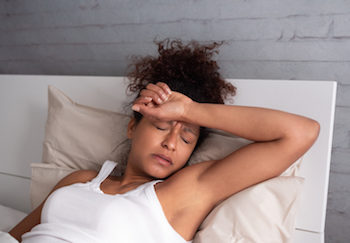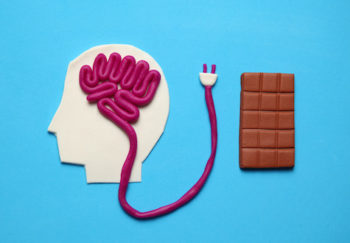
If you’ve ever experienced a migraine, then you know it’s much more than just a headache. It’s a combination of symptoms that – together – can be debilitating. Many sufferers find themselves searching beyond their doctor’s office for tips on how to relieve a migraine.
We asked neurologist and migraine expert Robert McMahon, MD, to give us the lowdown on common and complementary or alternative migraine treatments available today. But first, we asked him some basic migraine questions.
Migraine Basics
What is a Migraine?
A migraine is a severe, often throbbing, headache that tends to occur mainly on one side of the head, according to McMahon. “Migraines are also accompanied by other symptoms. These may include nausea, potential for vomiting, light and sound sensitivity, aversion to odors, as well as confusion or mental clouding,” he adds.
You might experience vision disturbances, such as flashes of light or blind spots before migraines take hold. This is called migraine with aura or classic migraine. Most people, however, have common migraine or migraine without aura (vision disturbances).
Who is at Risk for Migraines?
Family history is a key factor. If members of your family suffer from these headaches, you may someday, too.
Around 18% of women experience migraines, three times more than men. Most women with migraines are of childbearing age; hormonal fluctuations trigger their migraines.
What Causes Migraines?
We don’t know the exact mechanisms that cause a migraine. But we do know that, for those who are likely to get them, there are a variety of triggers. According to McMahon, these include:
- Certain foods, such as alcohol and cured meats
- A shift in barometric pressure associated with weather changes
- Poor or irregular sleep
- A change in exercise habits, especially stopping a regular exercise routine
- Caffeine withdrawal
- Physical and emotional stress.
How to Relieve a Migraine — Or Prevent Them Altogether
How to relieve a migraine effectively varies from person to person. Some treatments help alleviate symptoms once they start; others help limit migraine frequency.
Standard Migraine Treatments
These treatments help reduce symptom severity within an hour or two.
Simple Fixes
Some sufferers find relief by responding quickly to the first signs of a migraine. Finding a quiet, dark place to relax; taking a nap or drinking a caffeinated beverage may put an end to the headache. But “people with moderate to severe migraines likely will not get consistent results from these simple behaviors,” cautions McMahon.
Over-the-Counter Medications
Medications like ibuprofen, acetaminophen or headache powders help many people manage mild, infrequent migraines. Yet if you’re taking more and more of these medications to get results, you may experience headaches caused by overuse.
“Your brain can get used to seeing the medication, so it becomes dependent. In the absence of the medication, you can get a second type of headache in addition to the migraine,” says McMahon. “These can be difficult to treat.”
So if you feel like you’re overdoing the over-the-counter medications, talk to your doctor about alternative treatments.
Prescription Medications
A family of medications call triptans help patients relieve significant and recurrent migraine symptoms.
Complementary Migraine Treatments
In most cases, science doesn’t back these alternative approaches to migraine treatment. But they’re still effective for many people. You might use them on their own or with other treatments.
Ear Piercing
Although there’s only anecdotal proof that it works, some find that daith piercing or piercing the cartilage within the ear helps relieve migraine tendencies.
Cooling Caps
Cold compresses can dull head pain with a numbing effect. A newer hands-free device allows migraine sufferers to slip ice packs into a helmet to keep them in position. You typically use this in combination with other treatments.
Tinted Glasses
Because bright light can be a trigger, glasses with reddish lenses can help lower the tendency for migraine.
Cefaly Device
Approved by the U.S. Food and Drug Administration (FDA), the Cefaly is a Star Trek-esque head device that delivers micro impulses to the trigeminal nerves in the forehead. These are the nerves that send signals to the eyes, face and teeth. Cefaly can be used to prevent migraines or relieve symptoms after they start.
Preventing Migraines
You can also try preventive treatments to help limit the frequency of migraine headaches.
Medications
People take these common drugs daily to help decrease the occurrence of migraines:
- Antidepressants
- Blood pressure medications, such as beta blockers and ACE inhibitors
- Anti-seizure medications.
Lifestyle Changes
Poor diet, a change in exercise routine and irregular sleep habits can all trigger migraines in those prone to them. So taking better care of yourself is key to prevention.
Stress Relief
To help alleviate stress, a leading migraine trigger, doctors may prescribe cognitive behavioral therapy (talk therapy) or other methods to promote relaxation, such as meditation or massage.
Botox
You might think of Botox as a wrinkle treatment. But injections may help people with chronic migraines (15 or more days of headache over a period of three months or more).
“It can be really quite dramatic,” says McMahon. “Some people who have had lifestyle-limiting migraines for 30 to 40 years suddenly get their life back.”
Migraines Disrupting Your Life?
Make an appointment today with a UVA neurologist.
When It’s Time to See a Doctor
Every person experiences migraine differently. The key is to find a treatment that works for you. If migraines are disrupting your day-to-day life and you can’t control them with at-home or over-the-counter treatments, then it’s time to see a doctor.
“If headache is frequent enough or disabling enough to cause a degree of dysfunction — missing work or family activities, for example — then it’s reasonable for you to discuss migraines with your healthcare provider,” says McMahon.


I like how you mentioned that foods like alcohol and cured meats could be a potential cause for migraines. My wife is thinking of looking for a treatment center for migraines because she noticed last month that she had consistent painful headaches each week while at work. It seems like a good idea for my wife to think about going to a reputable establishment to help treat her painful headaches so she can feel as good as possible while working.
I really appreciate your work and helpful guidance on Ways to how I can rid of my migraine and headaches, The way you have provided detailed tips, awareness & Prevention that is very helpful to everyone!
it is imperative. Reading this post will make everyone feel better about the Migraine pain.
Thank you for making these details accessible. I like how you included some suggestions for remedies. Keep up the good work.
It’s great that you mentioned that Botox can be used to treat migraines. My wife has been having really bad migraines. We will have to schedule her a Botox appointment so that she doesn’t have to deal with them anymore.